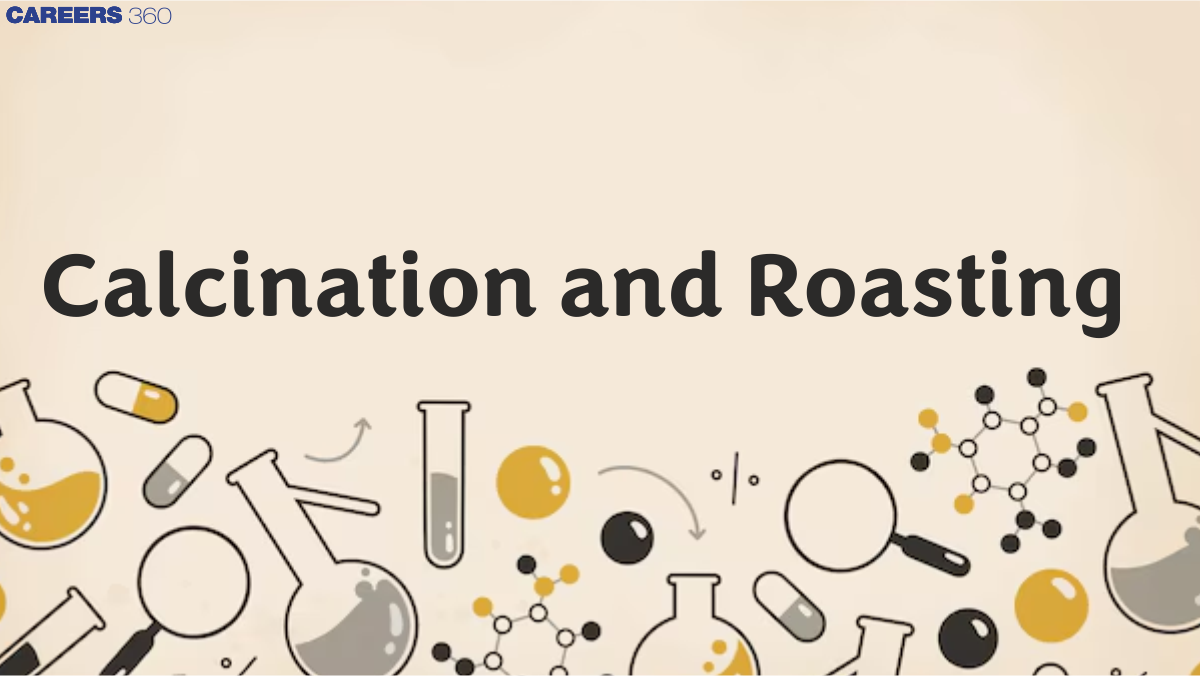Calcination and Roasting - Definition, Example, Principle, FAQs
The calcination and roasting processes in the conversion of ore into its oxide are two important topics that will be discussed in this paper. Calcination involves the process of heating ore without air to remove the volatile substances, whereas roasting is termed a process by which ore is heated in excess oxygen to enhance the removal of sulfur and other impurities. These processes are followed to create pure metal of high grade for use in diverse industries.
NEET 2025: Mock Test Series | Syllabus | High Scoring Topics | PYQs
JEE Main: Study Materials | High Scoring Topics | Preparation Guide
JEE Main: Syllabus | Sample Papers | Mock Tests | PYQs
- Roasting
- Significance and Uses
- Significance in Learning
- Some Solved Examples

Examples
- Calcium Carbonate (Limestone) CaCO3→CaO+CO2↑ Here, limestone is converted into calcium oxide, and carbon dioxide is released.
- Bauxite (Hydrated Aluminium Oxide) Al2O3⋅H2O→Al2O3+2H2O↑ Bauxite is converted into alumina, releasing water vapor.
Roasting
Roasting It is the heat treatment of ores in excess air to convert metals into their respective oxides and water-insoluble sulphides into water-soluble sulphates. It may, otherwise, be defined as a process for the deelectronation of ores, in which the process is centered on the removal of volatile impurities and the conversion of sulphide ores into the corresponding oxides. It essentially takes place in reverberatory furnaces.
Examples
Iron Sulfide In excess air, pyrite, FeS₂, oxidizes to give iron oxide, Fe₂O₃, and sulfur dioxide,
SO₂: FeS₂ → Fe₂O₃ + SO₂
The above process chain may merely be used as a way of changing the sulfide ore to a more reactive oxide form—the method also removes sulfur impurities.
Cinnabar Mercury ore- Roasting of cinnabar HgS, produces mercury oxide {HgO} and sulfur dioxide, SO₂. The ore becomes an oxide; this making the extraction of mercury to be more comfortable.
Zinc Sulfide Zinc sulfide ZnS is roasted to get zinc oxide {ZnO} and sulfur dioxide {SO₂}. This method turns the sulfide ore into an oxide and makes it fit for further reduction.
Lead Sulphide {PbS} is roasted to yield lead oxide {PbO} and sulphur dioxide {SO₂}. The processing of the ore into the oxide form makes it more reactive and thus easier for reduction to metallic lead.
Related Topics
Significance and Uses
Some of the predominantly used processes in the production of metals, which are used in various industries, include calcination and roasting. For example, the steel industry requires calcined limestone to act as a flux in the elimination of impurities in producing steel. Roasted zinc and copper ores are important in the making of parts donned by electronics, construction, and transport.
Significance in Learning
Processes that are hugely fundamental to the courses for learners in Chemistry and Metallurgy as in Material Science, Environmental Engineering, or Industrial Chemistry, since they assist in having an idea of the applications and the environmental impact caused by the extraction of the metals from their respective ores.
Also read :
Some Solved Examples
Example 1:
Which of the following factors is of no significance for roasting sulphide ores to the oxides and not subjecting the sulphide ores to carbon reduction directly?
1)CO2 is more volatile than CS2
2)Metal sulphides are thermodynamically more stable than CS2
3)CO2 is thermodynamically more stable than CS2
4) Metal sulphides are less stable than the corresponding oxides
Solution
The reduction of metal sulphides by carbon reduction is positive whereas, ΔG is negative for the same process with metal oxides. So, metal sulphides are more stable than oxides.
Hence, the statement given in Option 4 is incorrect:
"Metal sulphides are less stable than the corresponding oxides"
Hence, the answer is the option (4).
Example 2:
The purest form of commercial iron is:
1) wrought iron
2)pig iron
3)scrap iron and pig iron
4)cast iron
Solution
The purest form of iron is wrought iron.
Hence, the answer is the option (1).
Example 3:
The process that involves the removal of sulphur from the ores is :
1) Roasting
2)Leaching
3)Smelting
4)Refining
Solution
In the roasting process, metal sulphide (MS) ore is converted into metal oxide, and sulphur is removed in the form of SO2 gas
2MS+3O2→Δ2MO+2SO2↑
Hence, the answer is the option (1).
NCERT Chemistry Notes :
Frequently Asked Questions (FAQs)
Burning Without Oxygen is called pyrolysis. There, pyrolysis is a reaction to chemical decomposition that involves ranging from low to very low oxygen, or at least the insufficient oxygen required for heating.
In iron carbonates, a calcination process is performed to convert iron carbonates into carbon dioxides and iron oxides.
Calcination is sometimes called solid cleaning because the high temperature of the material used is used to remove the flexible material and other oxidizing part of the weight etc.
Volatilizing Frying,
Oxygen frying,
Frying sulfur.
Also Read
06 Feb'25 11:59 PM
06 Feb'25 11:54 PM
09 Dec'24 11:00 AM
21 Oct'24 04:24 PM
07 Oct'24 02:35 PM
07 Oct'24 02:24 PM
07 Oct'24 02:17 PM
07 Oct'24 12:55 PM
04 Oct'24 07:17 PM